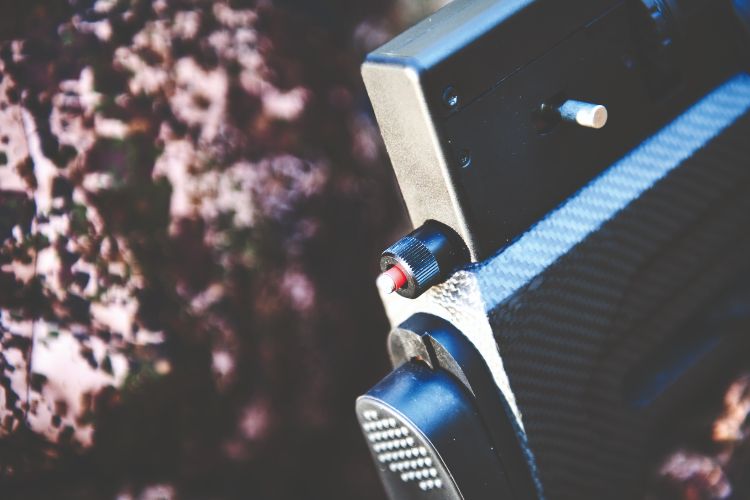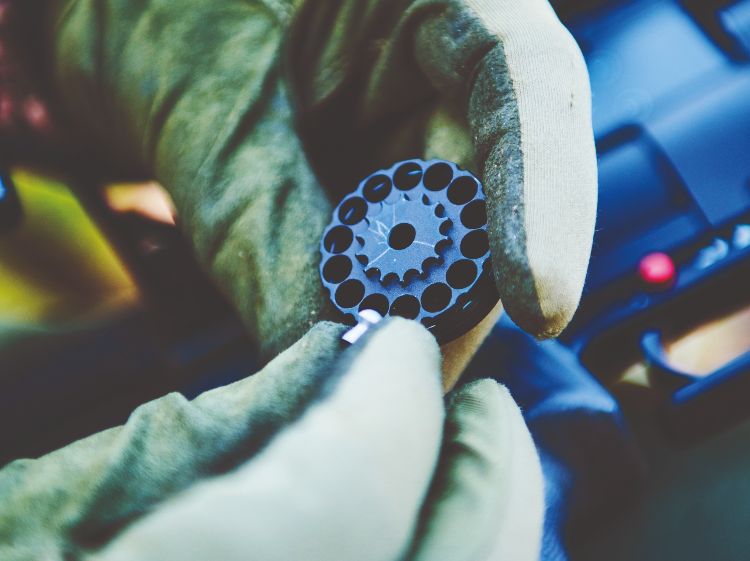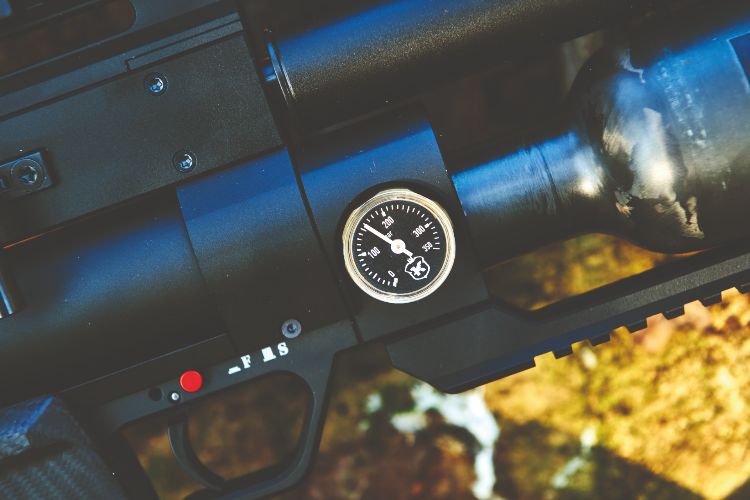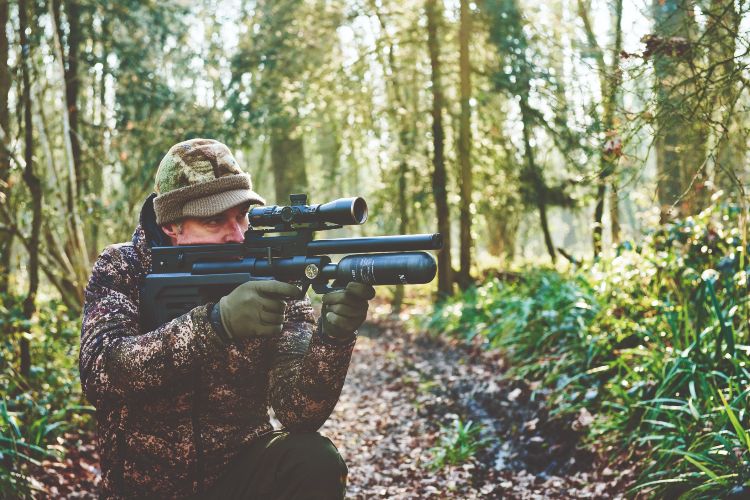The KalibrGun Cricket has established quite a cult following over the past few years; something which can most likely be attributed to its combination of super-compact proportions, eye-catching design, reliable performance and solid build quality. The gun has seen numerous tweaks since its inception in 2006 and the subject of this review, the Cricket II Tactical Carbon Fibre, brings it bang up to date both in terms of styling and performance.
This version of the iconic bullpup, made in the Czech Republic, has a recommended retail price of £1,950. That is serious money, but it buys you an accurate and dependable airgun that’s robust enough to survive heavy-handed use, and has certainly stood the test of time.
 TAKING STOCK
TAKING STOCK
There is no denying that the Cricket II Tactical’s carbon-fibre stock is kind on the eye – and it’s real carbon-fibre, not a plastic imitation. Aesthetically, it works very well with the black anodised metalwork and has the bonus of a flash-free finish – so while it will turn heads on the range, it won’t attract unwanted attention from sharp-eyed quarry in the field. The stock also feels very tough, and no doubt plays a significant role in keeping this gun’s overall weight down to 3.4kg.
Starting at the rear of the ambidextrous handle, its hard rubber butt pad is height-adjustable in order to achieve correct alignment between your eye and your chosen optic. The cheek support is not integral to the main carbon-fibre stock, but is a long polymer casing which sits above the magazine housing and the rear section of the barrel. As cheek supports go, it is very basic in design, although its top edges have been rounded off to make for a reasonably comfortable contact point with your face.
Returning to the main stock, the steep pistol grip is nicely contoured with a palm-filling swell and ensures good trigger attack. I have large hands and still found it to be very comfortable. Behind the grip is a large and nicely styled thumbhole cutaway, and behind that is a slot with capacity to store two spare magazines securely. There has been a lot of functionality built into this stock, and useful features include a rear sling attachment on the left-hand side and an underside accessory rail at the front.
 SECURE HANDLING
SECURE HANDLING
As with many modern bullpup airguns, the air bottle serves as the front section of the stock. It’s an arrangement that I find to be absolutely fine, although – because of this version of the Cricket II Tactical’s very short proportions – you do have to be careful not to let your fingers stray in front of the muzzle. One way to get around this potential hazard is to fit a silencer to the half-inch UNF thread at the front of the gun’s chunky shroud. Most hunters will probably do that as a matter of course, but it also helps to ensure that the pellet emerges safely forward of your fingers.
Of course, the true test of any gun’s stock is how it handles, and in this case, it serves that purpose very well. The Cricket II Tactical is a well-balanced and very pointable airgun and, although the stock is devoid of any stippling, it didn’t feel particularly slippery and I was always able to maintain a secure purchase, even when carrying it around the woods in drizzly conditions. Being such a compact airgun – just under 710mm from butt to muzzle with a 365mm length of pull – the Cricket II Tactical’s handling really shines in cramped conditions, and it would lend itself brilliantly to pest control operations in the confines of a hide, or inside farm buildings when longer guns can feel like something of an encumbrance.
 FEATURES AND FUNCTION
FEATURES AND FUNCTION
The review gun was supplied in .22 calibre, and runs a 14-shot magazine (as does the .177 option), and a spare is supplied as standard. The design of the magazine is very simple; it is a metal drum that’s been machined with chambers for pellets and a cog for indexing. Don’t be discouraged by that simplicity, though – it means that there is virtually nothing to go wrong and it’s a doddle to load. The Cricket’s magazine also seems to be very pellet-friendly, and can accommodate ammo up to about 9mm in length.
The magazine can be loaded from either side, just remember to pull back the retainer switch before you try to insert or remove it, and return the pin to its forward position when the magazine is in situ. The review gun was equipped with a 3D-printed stop made by JB3D. This clever little gadget prevents you from pushing the magazine all the way through and back out the opposite side of the slot – it’s simple but very effective.
Sidelever actions are becoming increasingly popular, and the one on this airgun is positive and reliable. The rear stroke cocks the action and indexes the magazine while the forward stroke probes a pellet smoothly into the breech.
I particularly like the fact that a red indicator at the rear of the action provides visual confirmation that the gun is cocked. That indicator is positioned within what looks like a power adjustment dial, although the feature has been disabled on sub-12 UK models to prevent muzzle energy from exceeding the legal limit.
Positioned above the pistol grip, and adorned with a smooth dropdown handle, the sidelever is well located for intuitive operation, and I soon found myself cycling it back and forth without having to think about where my hand was going. The good news for left-handers is that the sidelever can also be swapped across to the opposite side.
 TWO-STAGE TRIGGER
TWO-STAGE TRIGGER
Triggers on bullpup airguns can sometimes feel a little spongy as a result of the long linkage that’s usually necessitated by their configuration. The Cricket II Tactical has a two-stage trigger, and it is pretty good for a bullpup. The first stage on the test gun was fairly short and came to a clear stop. There was a small amount of creep in the second stage, but the break-point was predictable as long as I was positive with it. I believe that review guns should be tested with their triggers set as they leave the factory, but the Cricket II’s can be adjusted via two screws that are accessed by removing the stock.
The actual design of the trigger blade is very nice. It has a gentle curve and its wide, flat front edge transmitted plenty of feel to the pad of my index finger. There is a manual pin-type safety catch positioned just above the trigger blade, where it is very easy to access. It’s in the ‘safe’ position when pushed across from the left side to protrude on the right. Push it back from the right and the gun is ready to fire.
Engineering and finish look very tidy, and I couldn’t find any obvious shortfalls in these departments. The review gun was fitted with a 450mm long-choke barrel and 350cc carbon bottle – there is also a 600mm barrel option with 500cc bottle. Scope attachment is by means of a Picatinny-type rail which provides around 185mm of clamping space – that should be sufficient for most optics.
POWER AND PERFORMANCE
The Cricket II Tactical is equipped with a regulator, and overall consistency was reasonably good, coming in with a variation of nine fps over a string of ten shots. The test gun was producing a very punchy muzzle energy of around 11.8 ft.lbs. Maximum fill pressure is 300 bar, but Vector Air recommends 250 bar, which should return around 200 shots. Air pressure is displayed on a clearly marked gauge just behind the neck of the bottle on the right-hand side of the gun, so it's easy to keep an eye on your reserves. The inlet is on the opposite side and refilling is a simple task of removing the plug and connecting the supplied quick-fill probe.
 ON THE RANGE
ON THE RANGE
Put to the real test on the range, the Cricket II Tactical gave a good account of itself. Shooting from the bench in the gentlest of breezes, I managed groups barely larger than the nail of my index finger at 40 metres and a couple that fell within 20mm at 45 metres. Once I’d worked out my holdover, 40mm spinners were at dead cert at 50 metres. Best results were with Air Arms Diabolo Field ammo, but this airgun wasn’t particularly pellet-fussy – KalibrGun has a reputation for using decent barrels and that factor no doubt plays a significant part.
The review gun was supplied with an MTC Copperhead 3-12 x 44 F2 scope already fitted. This stubby little optic really suited the Cricket II Tactical’s proportions, both in terms of aesthetics and handling. It took me a little while to tune in to the trigger break point, but once I had, I was knocking out some respectable groups from sitting and kneeling positions – that’s always reassuring as you can’t rely on the comfort and stability of a bench out in the hunting field.
To sum up, I can see why the Cricket has earned itself such a loyal following, and I have no doubt that the latest Tactical Carbon Fibre model will win it even more fans. It is a versatile and reliable bullpup and, most significantly, there is something very satisfying about shooting it. On top of that, it also feels to be built like a tank. I only had the pleasure of shooting it for a few weeks, but it certainly felt like an airgun that should give years of good service with minimal maintenance.
TECH SPECS
Manufacturer: KalibrGun, Czech Republic
Model: Cricket II Tactical Carbon Fibre
Type: Multi-shot bullpup PCP
Stock type: Carbon-fibre tactical
Cocking: Reversible sidelever action
Trigger: Two-stage, adjustable
Safety: Manual
Calibres: .177 and .22 (tested)
Overall length: 710mm (28in)
Barrel length: 450mm (17.72in) and 600mm (24in, tested)
Weight: 3.4kg (7.5lbs) without scope
Fill pressure: 300 bar (250 recommended)
Shots per fill: 200
Energy of test rifle: Avg 11.8 ft.lbs. over 10 shots
Variation (10 shots): 9fps
Website: vector-air.co.uk
RRP: £1,950 (for model tested)